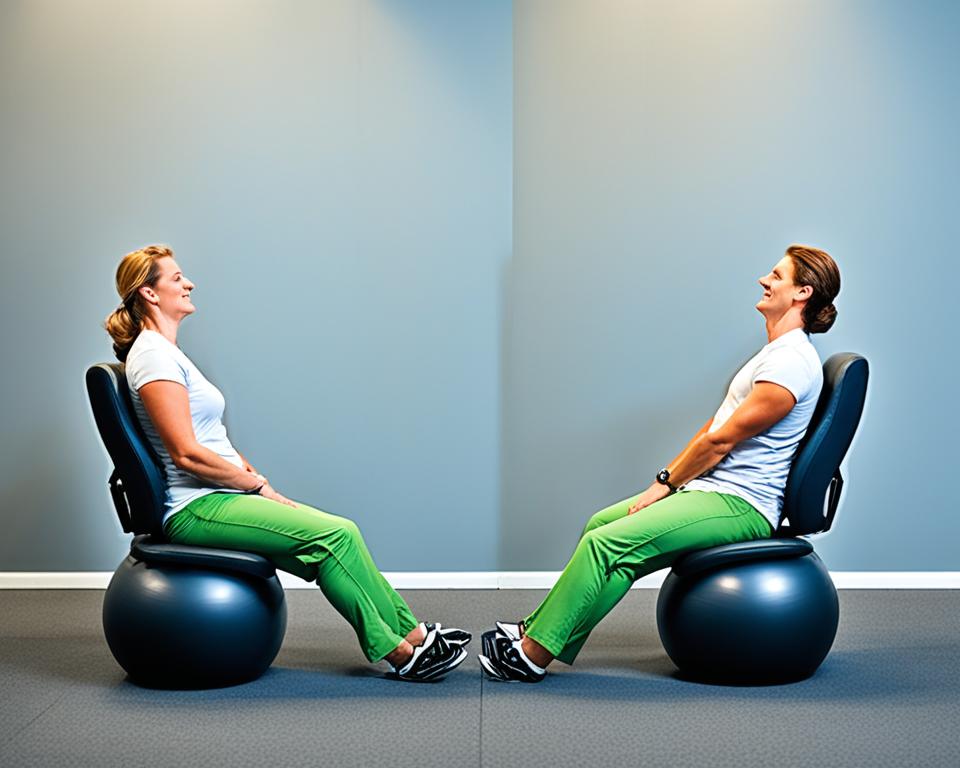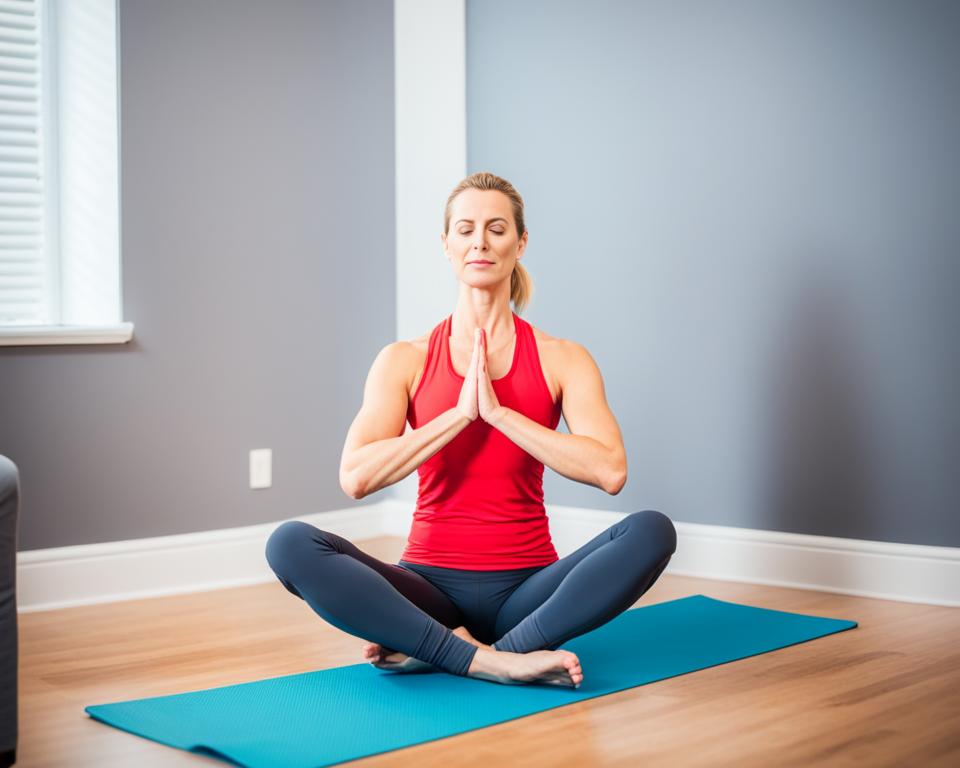Did you know sitting for long periods can make SI joint pain worse? Millions feel this, finding it hard and painful to sit. If you have SI joint pain, don’t worry. There are ways to sit comfortably and manage the pain well.
We’ve got some good advice on sitting better with SI joint pain. Whether it’s a constant issue or comes and goes, these tips can help. They’ll make finding a pain-free way to sit easier. Just by adjusting how you sit and your seating, you can feel better and improve your life.
Understanding the Anatomy and Causes of SI Joint Pain
Anatomy of the Sacroiliac Joint
The SI joint is in the pelvis, linking the sacrum to the ilium. The sacrum is a triangular bone at the spine’s base. And the ilium is part of your hip. Ligaments and muscles support the SI joint. They keep it stable and allow some movement.
Common Causes of SI Joint Pain
Many things can lead to SI joint pain. These include:
- Pregnancy: Changes in hormones can make SI joint ligaments looser. This puts more stress on the joint.
- Injury: Falls or other impacts can hurt the SI joint. This causes pain.
- Arthritis: Arthritis, like osteoarthritis or ankylosing spondylitis, can also affect the SI joint.
- Imbalance or misalignment: It might be because of muscle imbalances or uneven leg lengths. Even wrong spinal alignment can stress the SI joint.
- Overuse: Doing activities that involve a lot of twisting, bending, or lifting, again and again, can tire out the SI joint. This leads to pain.
Knowing the SI joint’s anatomy helps find the causes of its pain. This is key to treating it effectively.
Adopting a Pain-Free Sitting Posture
Having the right sitting posture is key to lessening SI joint pain and keeping your back healthy. It’s important to sit correctly to ease strain on joints and avoid pain. Let’s look at some tips for getting your sitting position right to avoid pain:
- Maintain a neutral spine position: Tip number one is to sit upright, keeping your spine aligned naturally. No slouching or leaning forward. Think of a string pulling you upwards, lengthening your spine. This helps keep everything in place.
- Position your thighs correctly: Your thighs should be flat and your knees at a 90-degree angle. Don’t cross your legs; this can strain your joints. A footrest might help you keep a better thigh position.
- Shift your weight regularly: Long periods of sitting can lead to pain. Try moving and changing how you sit at least every half hour. This takes the pressure off your joints and boosts blood flow.
- Utilize armrests and seat cushions: Use armrests to keep your upper body relaxed and a chair with comfy, adjustable armrests. A seat cushion can also make your sitting experience more supportive and comfortable for your back.
- Consider using an adjustable chair or standing desk: Adjustable chairs fit your body better, often reducing discomfort. Standing desks let you stand and sit, offering a good alternative to sitting all day.

How to Sit with SI Joint Pain?
This part gives you tips on how to sit safely and manage SI joint pain. You can help ease discomfort and improve how your spine lines up by changing where and how you sit. Firstly, it’s important to practice ergonomic sitting for SI joint pain. This involves maintaining a neutral posture that supports your spine’s natural curvature. Sit with your feet flat on the floor and keep your hips and knees at a 90-degree angle. This helps distribute weight evenly and reduces stress on your SI joint.
Supportive Seating Adjustments
When you have SI joint pain, you need to adjust your seat for support and good posture.
Here’s how you can do that:
- Use a SI joint pain cushion or lumbar roll to support your lower back.
- Set the chair height so your knees are at or below your hips.
- Put up a footstool to lift your feet and make sitting more comfy.
- Try different ways of sitting, like on cushions or kneeling, to lessen pressure on your SI joints.
Alternatives to Traditional Seating
If regular seats make your SI joint pain worse, look at other seating choices. These options can help you feel better and sit correctly:
- Get an ergonomic chair designed for si joint pain. It supports your back well and promotes good sitting posture.
- Think about a kneeling chair. It helps with an open hip angle and less pressure on your SI joints.
- Use an exercise ball instead of a chair. It makes your core muscles work and improves your posture.
By adjusting your seat and trying different ways to sit, you can ease SI joint pain. Finding comfort is possible!
At-Home Remedies and Exercises to Alleviate SI Joint Pain
SI joint pain can be reduced with at-home methods and exercises. These aim to make you more mobile, make surrounding muscles stronger, and stop more pain. Try these exercises often to feel better. One of the most important things to remember when dealing with SI joint pain is how you sit. Proper sitting positions can greatly alleviate the discomfort and prevent further aggravation. To sit with SI joint pain, it is crucial to maintain good posture. Sit up straight, with your feet flat on the ground, and avoid crossing your legs. This helps to distribute your weight evenly and relieve pressure from the SI joint.
SI Joint-Friendly Stretching and Strengthening Exercises
Doing stretches can ease tightness and make the SI joint area more flexible. Try these easy stretches:
- Standing hamstring stretch: Stand with your feet apart. Stretch one leg in front and bend at the waist to touch your toes. Do this on both sides for 30 seconds.
- Child’s pose: Kneel and sit back on your heels. Stretch your arms forward. Hang in this pose for 30 seconds.
- Pigeon stretch: From a push-up pose, draw one knee to your hands and place it behind the same wrist. Lower your chest to the leg and relax for 30 seconds on each side.
- Bridge exercise: Lay on your back with knees bent, and feet down. Lift your hips, tighten your glutes and core. Keep up for 10 seconds, then lower. Repeat.
- Clamshell exercise: Lay on your side with your knees bent. Keep your feet together. Lift the top knee without moving the feet. Do this ten times on each side.
It’s also vital to make your SI joint muscles stronger for support and balance. These workouts can help:
- Bird dog exercise: Start on hands and knees. Stretch one arm and the opposite leg. Hold briefly, then change sides. Do this 10 times on each.
- Side plank: Lie on your side with your forearm on the floor. Raise your hips to form a line. Keep for 30 seconds on each side.
- Glute bridges: Lay down with knees bent, and feet flat. Push your hips up while squeezing your glutes. Lower and repeat 10 times.
- Wall squats: Stand with your back on a wall, feet apart. Slide into a squat, keeping your back flush. Hold for 30 seconds, and then stand up.
Incorporating Movement Breaks into Your Routine
Along with exercises, move around regularly during the day. Sitting too long makes SI joint pain worse. Stand, walk, or stretch every half hour. This keeps your joints from stiffening and eases SI joint stress.
Staying consistent with exercises and taking breaks can help reduce SI joint pain. It’s important for a pain-free life.

Managing SI joint pain when sitting can be done effectively. It requires the right strategies. By using the tips in this article, you can feel better while sitting.
It’s important to keep a good sitting posture. This means your spine should be straight and your thighs level with the floor. Shifting your weight often can also ease your sitting time. Don’t forget to utilize armrests and cushions. Adjustable chairs and standing desks are helpful too.
Make your seat more supportive by adding things like lumbar rolls. Adjust your chair’s height to fit your needs. Using footstools can also make a difference. Don’t be afraid to try out different chairs or sit on an exercise ball. These small changes can really help reduce your SI joint pain.
Include home treatments and exercises in your daily routine. Stretch and strengthen exercises are good for your SI joint. So are taking breaks to move around. This will make your joints more flexible, decrease pain, and stop discomfort.
With these strategies, dealing with SI joint pain when sitting can be easier. This will lead to a better, pain-free life. So, start working on your SI joint pain today and feel the relief.
FAQs
How can I sit with SI joint pain?
To sit comfortably with SI joint pain, keep a good posture. This means sitting with a straight back. Keep your thighs straight and weight evenly distributed. Armrests and seat cushions can make it more comfortable.
What are the common causes of SI joint pain?
SI joint pain can happen because of different things. This includes injuries, having a baby, arthritis, and conditions like ankylosing spondylitis. Bad posture and muscle problems are often related to this pain.
How can I adopt a pain-free sitting posture?
For a pain-free sitting posture, focus on your back’s position. Don’t slouch or arch your back. Keep your feet flat on the floor. Use adjustable chairs and standing desks to help keep your spine healthy.
What supportive seating adjustments can I make to alleviate SI joint pain?
To reduce SI joint pain, try using lumbar rolls for back support. Adjust your chair height for better posture. Use a footstool to relieve pressure on the joints. Kneeling with cushions can also help.
What are some alternatives to traditional seating for SI joint pain?
Kneeling chairs or exercise balls offer an alternative to relieve SI joint pain. They promote better posture and engage your core muscles. This lessens the stress on the SI joints.
What are some at-home remedies and exercises to alleviate SI joint pain?
There are many things you can do at home to ease SI joint pain. Try stretching and strengthening exercises that focus on the muscles around the SI joint. Add short movement breaks to your day to stay flexible and improve blood flow.
